Fifty-Cent Pieces of the Revolution, Campo Morado, 1915, Estado de Guerrero
by David Hughes
The following are a few interesting pieces.
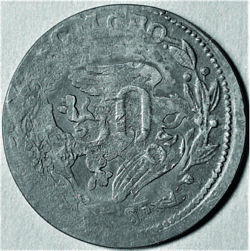
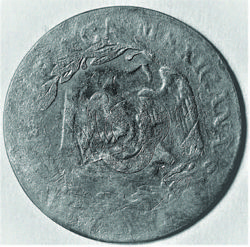
C.M.GRO. 1915 50-centavos GB-157-VAR, dies (1/A), the first issue of the 50-centavo series. This piece is overstruck on a Federal bronze 1915-Mo 5-centavos, and appears to be a pattern strike or die trial strike, pairing the new CoMo 1915 50-centavos die A with the Estado Guerrero 1914 UN PESO eagle-die 4. UN PESO appears filed off the coin instead of effaced off the die (there are file marks on the coin and on the ghost of the O in PESO). This eagle die and another eagle die were subsequently modified for use on the early CoMo 1915 50-centavo strikes, by effacing the UN PESO on the die.
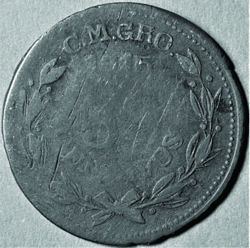
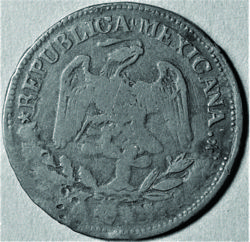
C.M.GRO. 1915 50-centavos GB-UNL, dies (3/A), a very rare and seldom seen variety in the series. A local die was used for the third effaced die, the 1914 UN PESO CAMPO Mo. eagle die. This die was subsequently used on GB-159, dies (3/B). A Below Average strike, alas, although the plate coin in Amaya (2015) does not look much better, suggesting an overall weakly-struck issue, so it may be a sleeper.

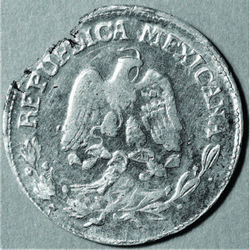
C.M.GRO. 1915 50-centavos GB-162-VAR, dies (5/A). This is a 10.87g silver strike, with the planchet punched out near the edge or end of strip (note the planchet flaw). A specific gravity of 10.13 was obtained from this piece, suggesting a silver planchet of approximately 0.77 fine, likely a peso planchet of semi-refined silver bullion.
Five silver strike varieties are noted in this series: this one, Leslie/Stevens (1968)Leslie, E. C. and Stevens, E. C., Coinage of the Mexican Revolutionist Zapata, privately printed, 1968. silver GB-157-VAR dies (1/A), Gaytan (1969)Gaytan, C., La Revolución Mexicana y sus Monedas, Mexico, D.F., 1969. silver GB-158-VAR dies (2/A), Amaya (2015)Amaya, Carlos, Tricolor Compendium of Mexican Revolutionary Coinage, Sociedad Numismática de Monterrey, Monterrey, NL, Mexico, 2015. “low silver alloy” GB-163-VAR dies (5/C), and Guthrie (1976)Guthrie, H. S. with Bothamley, M., Mexican Revolutionary Coinage 1913-1917, Superior Stamp & Coin Co., Beverly Hills, CA, 1976. Available in the USMexNA Electronic Library. base silver alloy GB-167 dies (7/A).
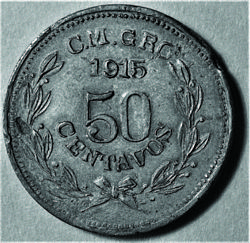
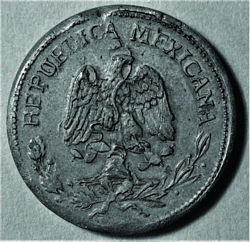
C.M.GRO. 1915 50-centavos GB-163-VAR, dies (5/C), early die state. This piece is a 4mm thick (!) polished edge presentation or specimen (a proof, for the times) strike. The die combination is too late in the series to be considered a pattern strike. This example is a beautiful full strike with a spectacular eagle, in medal die rotation, unlike the regular issue GB-163 with coin die rotation.
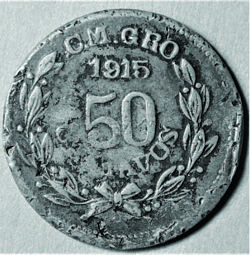
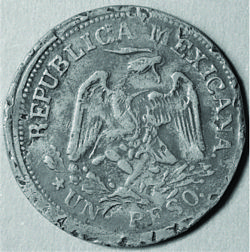
C.M.GRO. 1915 1.5-peso GB-UNL, dies (Estado Guerrero eagle-die 3/CoMo 50¢-die C), a mint sport from the Campo Morado mint. Two pieces are known, one silver and this one (copper), in about the same strike. The Estado Guerrero eagle-die 3 is an early die state, lacking the bottom waterline that extends from N to E of UN PESO. See detail below, left.
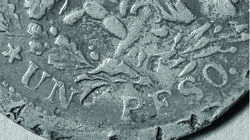
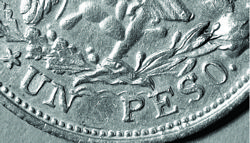
The water line was added before the striking of the Estado Guerrero 1914 silver UN PESO GB-200, dies (3/Aa) (above, right), showing eagle-die 3 was used on a 1915 coin (albeit mint sport) before it was used on a 1914 UN PESO. This eagle die was also used on the Estado Guerrero 1914 GB-201/202 (dies 3/C), the common Taxco 1915 1-Peso GB-231, and the rare Taxco 1915 1-Peso GB-234. The CoMo 50¢ die C was used with two other eagle dies, eventually shattering (see image below).
While puzzling this coin through I assumed one of Joe Flores’ favorite pieces, a well struck silver Campo Morado 1915 1.5-peso (Flores, 1998, Bailey/Flores, 2005) was this die combination. Deciding to be sure, I checked: surprise, it was struck using dies (Estado Guerrero eagle-die 4/CoMo 50¢-die A). So, there is more than one variety of this mint sport.
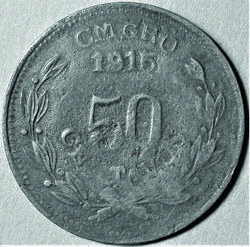
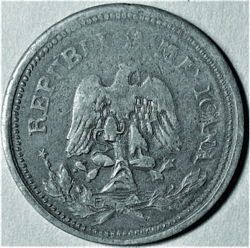
C.M.GRO. 1915 50-centavos GB-165.5, dies (6/E), 50¢-die E not pictured in the GB catalogue. Leslie/Stevens (1968) and Guthrie (1976) describe denomination die E as: wreath berries, 7 each side, and are 2-2-2-1 on the left and 1-2-2-2 on the right, from the tie. A rare variety in the series.
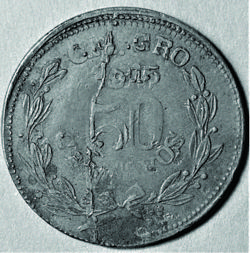
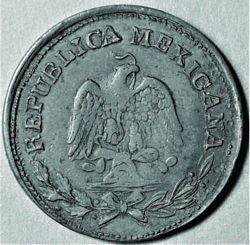
C.M.GRO. 1915 50-centavos GB-UNL, dies (eagle-die UNL/C), prepared late in the series, and struck on a thin planchet, which was likely hard on the dies. The unlisted eagle die has the R of REPUBLICA reengraved over a star (see below). Also noted: in MEXICANA the X is lower than the E, the I is lower than the X, the C is lower than the I, and the A is higher than the C. Denomination die C is in a very late die state with a crack across the entire die, the die likely shattered, resulting in a rare die combination.

These are pieces not in the GB catalogue, die trials, mint sports, presentations, specimen strikes, proofs of the times, and rarities. So, go check that ugly Campo Morado 50-centavo, figure out what it is, there may be another unlisted or mystery combination out there.
